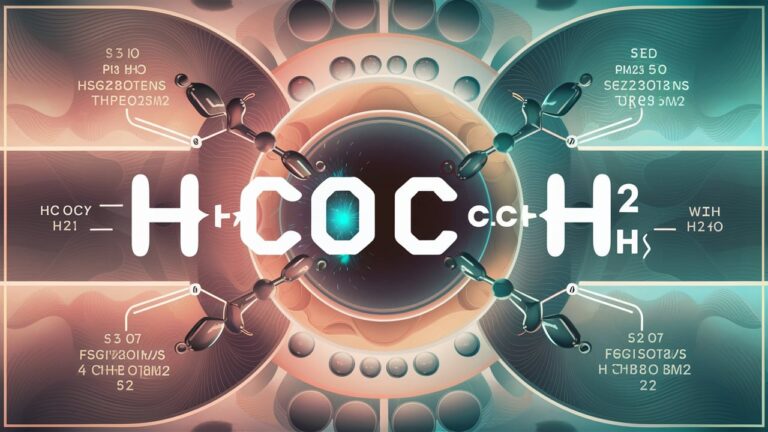Chemistry is full of fascinating compounds and reactions that form the backbone of modern science. One such reaction involves hcooch ch2 h2o, which often comes up in discussions of organic chemistry and chemical processes. Understanding these components is crucial for students, researchers, and industry professionals who want to master reaction mechanisms and explore their practical applications. The combination of formic acid derivatives, methane components, and water plays a significant role in different chemical pathways that influence both laboratory research and industrial chemistry.
HCOOCH CH2 H2O: Understanding the Chemical Reaction
The formula HCOOCH CH2 H2O can be broken down into three key components: HCOOH (formic acid or formyl group), CH2 (methylene group), and H2O (water). When combined under certain conditions, they can participate in reactions such as hydrolysis, substitution, and condensation reactions. This highlights the importance of understanding the underlying chemistry, as small changes in molecular interaction can lead to entirely different products. Chemists use such reactions to predict outcomes, synthesize compounds, and create new molecules that are used in medicine, energy, and materials science.
The Role of HCOOCH, CH2, and H2O in Organic Chemistry
Each component in HCOOCH CH2 H2O serves a specific purpose in organic chemistry. HCOOH (formic acid group) is one of the simplest carboxylic acids, often used as a reducing agent or intermediate in chemical reactions. The CH2 (methylene group) is a fundamental building block in organic molecules, linking carbon structures together and allowing for polymerization. Finally, H2O (water) is the universal solvent and an active participant in hydrolysis, hydration, and acid-base chemistry. Together, these compounds illustrate how small molecules combine to form the basis of larger, more complex organic structures.
Detailed Explanation of the HCOOCH CH2 H2O Reaction Mechanism
The reaction mechanism of HCOOCH CH2 H2O depends on the reaction conditions such as temperature, catalysts, and pH levels. In many cases, the reaction involves hydrolysis, where water breaks down the bonds within the compound to produce new molecules. For example, formic acid esters (HCOOCH) can undergo hydrolysis in the presence of water to yield formic acid and alcohols. The CH2 group, depending on its placement, can either stabilize the reaction or act as an intermediate in forming larger organic structures. This mechanism is widely studied in organic chemistry labs because it helps explain how simple molecules transform into more complex ones.
Applications of HCOOCH CH2 H2O in Chemistry and Industry
The HCOOCH CH2 H2O reaction has multiple applications in both laboratory and industrial settings. In the chemical industry, formic acid derivatives are used in preservation, antibacterial agents, and leather processing. The methylene group (CH2) plays a central role in polymer science, particularly in creating plastics and resins. Water, of course, is essential in nearly every chemical process, from synthesis to purification. Together, the interaction of HCOOCH, CH2, and H2O represents a foundation for industrial production of solvents, fuels, and organic compounds that we use in daily life.
Future Research on HCOOCH CH2 H2O and Its Importance
Although HCOOCH CH2 H2O may appear simple, research continues to reveal its importance in emerging fields like green chemistry and renewable energy. Scientists are exploring how these small molecules can contribute to more sustainable industrial processes. For example, formic acid is being studied as a potential hydrogen carrier for clean energy storage. The methylene group is at the core of designing new biodegradable plastics, while water remains the medium of choice for environmentally friendly reactions. The future of chemistry lies in harnessing such reactions for innovation and sustainability.
Conclusion – Why HCOOCH CH2 H2O Matters in Chemistry
In conclusion, the HCOOCH CH2 H2O reaction is more than just a chemical equation. It represents the interconnectedness of organic chemistry, industrial applications, and future research in sustainability. By understanding the role of formic acid derivatives, methylene groups, and water, we gain deeper insight into how simple compounds can lead to groundbreaking discoveries. As science progresses, the importance of these reactions will only grow, making them essential knowledge for chemists, researchers, and students worldwide.
Frequently Asked Questions (FAQ)
Q1: What does HCOOCH CH2 H2O represent?
A: It represents a chemical reaction involving formic acid derivatives (HCOOH), methylene groups (CH2), and water (H2O), often studied in organic chemistry.
Q2: What is the role of H2O in the HCOOCH CH2 H2O reaction?
A: Water acts as both a solvent and a reactant, often enabling hydrolysis and other reaction pathways.
Q3: Is HCOOCH CH2 H2O important in industry?
A: Yes, formic acid derivatives and methylene groups are widely used in plastics, fuels, preservatives, and green chemistry innovations.
Q4: How does HCOOCH CH2 H2O relate to organic chemistry?
A: It demonstrates key principles of reaction mechanisms, hydrolysis, and molecular interactions, making it important in organic chemistry studies.
Q5: What future applications are expected for HCOOCH CH2 H2O?
A: Potential uses include hydrogen storage for clean energy, development of sustainable plastics, and eco-friendly industrial chemistry processes.
